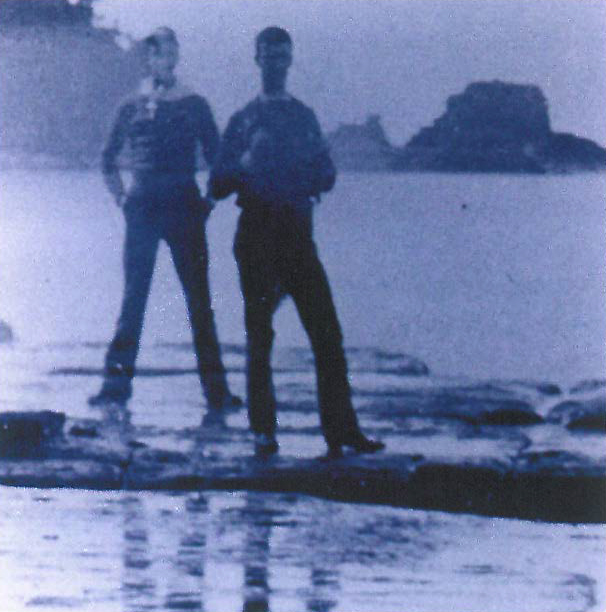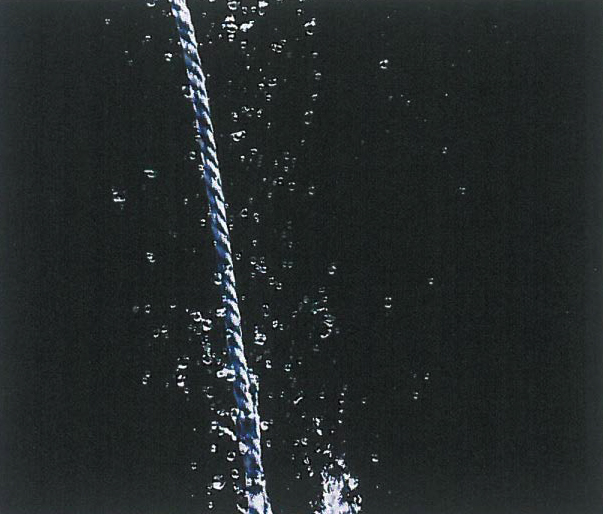
Simon Cuthbert's diverse and engaging images in the show The Sea are a logical extension of his practice, over a number of years, informed by museology and history and his work as photographer at the Tasmanian Museum and Art Gallery. Type C print images of male figures rephotographed from 1895 originals are some of the most unusual, evocative works in the show. Sent to the Tasmanian Museum from a variety of sources, these photographs were originally taken around the Tasman Peninsula, a region well known as the site of the Port Arthur penal settlement and more recently the 1996 massacre, as well as being popular with photographers and holidaymakers for over one hundred years.
From a series now entitled Contest of Meaning the works depict anonymous figures, possibly mariners in their stripey jerseys, in a series of mostly casual poses - reclining at the water's edge, seated on rocks, standing on an outcrop in the water, wading, and so on. Their informal poses seem incongruous in works over a century old; there is none of the static formality characteristic of more typical Victorian photography. The images are all carefully reproduced and blue-toned from sepia originals, their primitive technology (fuzziness, parts of some images fogged and obscured, distortions, degradations of age, etc.) made a virtue by Cuthbert's skilful hands. These are relatively large works (70 x 70 cm) and their size contributes to their impressiveness, as does their very real novelty.
Also reflecting Cuthbert's art museum practice are three monumental works After Duke #3, #5 and #6, close up details from one of the nineteenth century paintings in the Tasmanian Museum, a dramatic image of a rescue of a number of sailors on a whaling expedition. From the William Duke original Whaling with the Aladdin and Jane, Cuthbert has chosen to zoom in on a powerful and rather overwhelming close-up of a whale diving for cover, sailors being hauled into a lifeboat and, slightly disconcertingly, the ship's banner with the name 'Aladdin' seen in reverse.

This work was originally inspired by the 1996 Port Arthur horror and has clear Biblical overtones: the idea of the deluge, of desperate struggle, of fear and danger with the whale itself operating also as a symbol of hope - and in this era, a reminder of the importance of ecology and sound conservation practices.
At the same time, silver gelatin prints of the rugged Tasmanian coastline, such as Tumbledown #1 and #2, Tasman Island are striking depictions of yet another aspect of the sea. They are strong, unashamedly stark photographs which emphasise the monumentality of the natural world. There is something almost abstract about Tumbledown #1 with its solid mass of sea in the foreground and its strangely truncated cliffs behind. An exploration of the sublime indeed. Other seascape works, including Jetty, Port Davey with its semi-submerged trees eerily protruding from the water are similarly awe-inspiring.
The minimalism of other works, notably Wanderer, Ben Hur and Passage makes a good counterpoint to some of the more complex or figurative images. These three blue-toned works have barely discernible renditions of strands of seaweed against what otherwise reads as an almost purely plain pictorial surface. In a nod to postmodernism, the works have their titles printed large, in cursive script, across their surfaces. They are intriguing works and tie in well with two similar images; Descent, a close-up of an anchor dropping into the blue underworld and Negotiating the Void, an almost abstract image of a thick strand of rope, again surrounded by the dense blue of the sea. Such works strongly speak of the physicality of the sea and the ultimate unknowability of the world below the surface. It is a minor detail, but some of these seaweed/seabed images are somewhat less than generously mounted and framed and a larger framing format might have made these very interesting images even more seductive.
Ascending Bubbles, while actually figurative, similarly succeeds in working as an exploration of abstraction or an investigation of patterning, and the three-part Variant Ascent continues this idea. These works have their origins in simple concepts, which Cuthbert has taken and maximised by virtue of his visionary abilities and technical skill.
Simon Cuthbert is a highly regarded mid-career artist, widely awarded and extensively collected. He has produced a show which successfully brings together six or seven different themes, topics and styles, which all dovetail neatly into the wider banner of The Sea, an accomplished and sophisticated exhibition.












